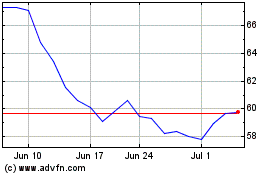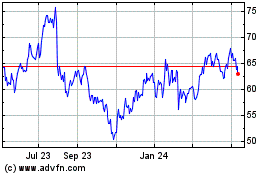By Yuka Hayashi
The growth of online lending has been a boon to hair salons,
bakeries and other small businesses that don't qualify for bank
credit. Yet this tech-enabled source of credit can mire some in
debt they can't repay, raising concern about inadequate
regulation.
Some are extending credit at sky-high rates with opaque terms
for costly fees and conditions, drawing comparisons with payday
lenders who target consumers in need of quick cash, according to
critics.
"There is a significant number of bad actors who are mostly
unregulated, " said Luz Urrutia, chief executive of Opportunity
Fund, a California nonprofit that lends in lower-income
communities. "They are really wreaking havoc across America's small
businesses."
Nearly a third of the small businesses surveyed applied for
online loans in 2018, up from 19% in 2018, according to a Federal
Reserve study. The market's growth is driven by loans of less than
$100,000, often as small as a few thousand dollars, according to
experts.
The biggest players in online business lending include major
names such as PayPal Holdings Inc., Amazon.com Inc. and Square
Inc., which use data collected through their e-commerce or payments
platforms to decide on offering small-business loans and at what
terms. Lending to small and medium-size businesses by the top five
digital platforms rose an estimated 39% in 2019 from the previous
year to $13.5 billion, according to S&P Global Market
Intelligence.
Most of the lenders don't make their fees public. An exception
is On Deck Capital Inc., one of the few that is publicly traded,
which charged annual rates ranging from 9% to 98.3% in the quarter
ended September, with an average of 45%. By contrast, long-term
bank loans guaranteed by the federal Small Business Administration
currently are offered to borrowers, with fairly good credit
histories, as low as 7%.
On Deck said it is "committed to providing fair and transparent
financing options," noting that it had led an effort to create a
standardized disclosure tool used by some large lenders.
But rates charged by smaller lenders can soar higher.
Opportunity Fund analyzed 150 online-loan contracts signed by
104 businesses in California before they came to the nonprofit
lender in 2016. It found the average rate for such loans was 94%
and the highest was 358%. Opportunity Fund charges 12% to 14% for
its loans.
Online lenders pepper business such as auto-body shops and
e-commerce stores with solicitations promising access to instant
cash with no credit checks.
But beyond the high interest rates, the complex structure of
some products and opaque disclosure make it difficult for borrowers
to understand costs.
Johnathon Bush, the owner of Not Just Cookies bakery in Chicago,
said he did a brisk business at farmers markets during the summer,
but he faced a cash crunch in November 2018, just as he was gearing
up for the holiday season.
After a bank rejected his loan application, he borrowed a total
of $38,000 from two online lenders, which required him to pay back
$56,000, including fees. The lenders immediately began withdrawing
$450 from his bank account every day, eating up most of his average
daily sales of about $600.
"I was able to eat and sleep, but there was nothing else left,"
said the 26-year-old Mr. Bush. "All the cash was going away fast."
After defaulting on his loans in January he was able to borrow from
family members, allowing him to keep his business.
He signed on to one of the murky products known as merchant cash
advances, which technically are advances on revenues, not loans.
Borrowers pay a fixed percentage of daily or weekly revenue rather
than interest. The costs of such products are sometimes in the
triple digits when converted into annual percentage rates for
loans. Giving access to the borrower's bank accounts is a common
practice in both payday lending and merchant cash advances.
In addition, many regulations to protect borrowers, such as
requirements to disclose interest rates and bans on discrimination,
apply to consumers, not businesses. Of the 30 million U.S. small
businesses, 24 million have no employees besides the owners,
according to the Small Business Administration.
"A vast majority of (borrowers) are consumers in every respect,"
said Glenn Christensen, associate professor of marketing at Brigham
Young University. "Yet the law treats them as sophisticated,
multimillion dollar companies."
Federal and state authorities are taking notice. California last
year passed legislation that requires online lenders to disclose
interest rates on small-business loans, just as they must for
credit card and auto loans. The Federal Trade Commission in May
said it planned to scrutinize unfair and deceptive practices in
small-business lending.
In some states online lenders must obtain licenses and follow
state interest-rate limits, sometimes set at 36% or lower, though
some states have no limits. Many lenders partner with nationally
chartered banks, which allow them to bypass state limits, a
practice that has been challenged in court.
However, online lenders have filled a void left by banks that
have limited small-business lending since the financial crisis
because it was risky or unprofitable. While they are increasingly
important sources of capital, online lenders' long-term prospects
remain uncertain, according to experts.
Unlike banks, which fund their loans from stable pools of
consumer deposits, online lenders mostly raise capital from hedge
funds and other investors -- money that could evaporate in times of
financial turbulence.
"The online lending industry is yet not old enough for two
things," said Adrienne Harris, a University of Michigan professor
and former Obama administration Treasury official. "One, to see how
it performs in a downturn or a credit crunch. Two, nobody has
really done the analytics to evaluate the trade off of increased
access to credit with potentially increased cost."
Write to Yuka Hayashi at yuka.hayashi@wsj.com
(END) Dow Jones Newswires
December 30, 2019 14:41 ET (19:41 GMT)
Copyright (c) 2019 Dow Jones & Company, Inc.
PayPal (NASDAQ:PYPL)
Historical Stock Chart
From Mar 2024 to Apr 2024

PayPal (NASDAQ:PYPL)
Historical Stock Chart
From Apr 2023 to Apr 2024
